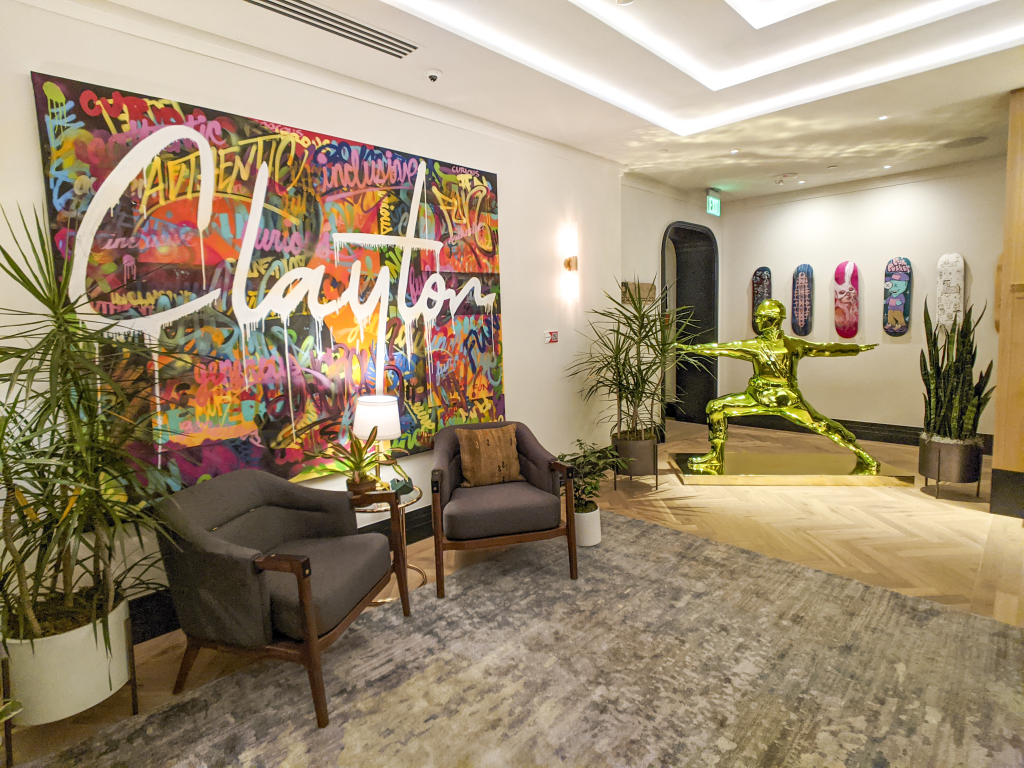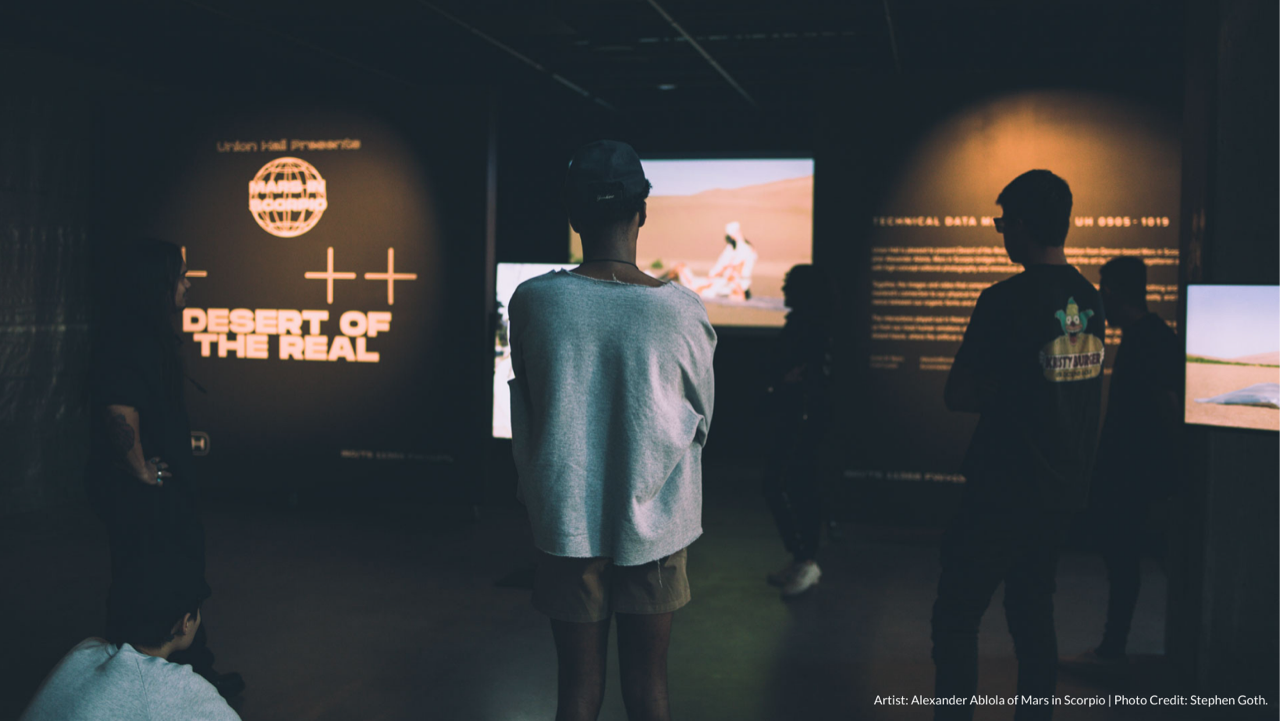Never has collaboration and connection been more important in our world. From in-office works spaces to local community inclusion, designers and artists must lean into the relational components of where we gather. After all, art turns spaces into experiences. We recently surveyed business leaders for our latest State of the Art Report and our findings showed that over 90% of the individuals we surveyed view art as a way to create a memorable experience that improves the quality of life for users of a space.
Art has long been heralded as good business. But now is the time to show how art also contributes to the building blocks of a thriving community.

PUBLIC VENUES PROMOTE INNOVATION AND IMPACT
The most successful public spaces have an energy that permeates the entire visitor experience, creating a heartbeat, a soul, that delights guests and invites them into a brand story. This energy is an essential component of placemaking, and it is one that is no longer optional.
As Walter Isenberg, CEO of Sage Hospitality Group says, “Placemaking is significant because the customer demands it. They want to go somewhere interesting, and they’re interested in experiences.”
A prime example of how experience and impact can work together in harmony is the community art space Union Hall. As a multipurpose arts and cultural venue located in Denver’s historic Union Station neighborhood, the nonprofit serves as a “cultural concierge” for the community. Union Hall features experimental exhibitions across a wide array of mediums and focuses. In addition, the space prioritizes partnering with other arts and cultural organizations throughout the larger Denver metro area. A weekly newsletter and social media outreach inform residents of unique, one-of-a-kind art events in and around the area, many of which showcase emerging and underrepresented local creatives.
Union Hall works to create a sense of place, engaging civil society and driving economic development. Ultimately, the venue understands that creative connection is vital to strengthening the local economy.
COMMUNITY ART SPACES SUPPORT DIVERSITY, EQUITY, INCLUSION AND BELONGING
Art is often a visual narrative. But the way in which that story is told and the individual who brings it to life, are as important as the story itself. That’s why it’s essential to consciously curate art with diversity, equity, inclusion and belonging in mind.
Over 80% of people surveyed believe it’s good business to celebrate diversity, equity and inclusion as part of art projects. Beyond being a smart business decision, investing in art can help demonstrate your values and build connections. Nearly 70% of stakeholders surveyed by NINE dot ARTS strongly agree that art’s goal is to build social and cultural capital. However, commercial partners that NINE dot ARTS surveyed reported that in their recent projects, only:
- 50% used a female artist
- 35% used a Black or Hispanic artist
- 15% used an artist from the LGBTQIA+ community
Thoughtfully cultivating diversity must be at the forefront of community art space planning. “Art and social impact and community engagement are huge,” says Sarah McGarry, principal at Stantec. “This is where our clients can tell a story that is supportive of different cultures and make a message of it.”
The Clayton Club puts this notion into action. Founded on the pillars of opportunity, equity and inclusivity, the club’s collection includes more than 235 paintings, photographs, sculptures, murals, and installations. Works commissioned for the Clayton Club are guaranteed fair and proper compensation. In addition, select artists can join the Clayton Community through contributions of art, programming or events in lieu of membership fees, all while keeping 100% of the profit of their displayed work.
This type of model allows underrepresented and emerging artists to showcase their talents and share their perspectives with visitors, volunteers, members and more.

MIXED-USE COMMUNITY SPACES FOSTER COLLABORATION
Collaboration is key to fostering new ideas. For organizations that want to foster co-working or community interaction, creativity should be a central component. Collaboration begins with shared goals for the space and the art itself. Meaningful, successful art experiences only happen when all stakeholders, decision makers and experts work in tandem toward a shared purpose.
According to Chad McWhinney, CEO and co-founder of real estate development leader McWhinney, “The best projects come from harnessing the collective wisdom of a talented team of people, all growing in the direction of a common vision.”
At Union Hall, for instance, a purposeful partnership led to a dynamic arts space supporting a wide variety of events and mediums, each requiring their own collaborations. The space itself is funded through a first-of-its-kind funding strategy – developed in partnership with other commercial businesses -which utilizes a transfer fee from the area condominium sales to support the flexible arts venue.
The Clayton Club’s goal of inspiring and enticing the entrepreneurial minds of its members was made a reality thanks to a partnership with an artwork loan program and arts education nonprofit. The collaboration has created a central meeting place for both creatives and business professionals.
Collaboration can also expand on brand values and foster community involvement with local creatives. In fact, over 95% of people surveyed say including local art is an effective way to support the community while garnering goodwill toward a project.
When the Bonfils-Stanton Foundation prepared to relocate, a central focus was on how to connect their brand and mission to the vibrant arts community in their new location. The end result was a variety of programming, exhibitions and collections that featured local artists and uplifted the rich history of the area. Bonfils-Stanton also took it one step farther by providing dual-language pamphlets on their art collection, expanding access for Spanish speakers.

HOW TO BEGIN CULTIVATING COMMUNITY IN YOUR PUBLIC SPACE
To begin the process of utilizing art to create community impact, remember your brand. Ultimately, who you are and what you stand for will help shape your creative vision and corresponding collection.
From there, ask yourself:
- What value does my brand bring to the table?
- How does my brand exist in relation to the local community?
- How can this art experience engage the local community and tell a compelling story?
Such questions can help guide your integration of art and culture into your space and create that “heartbeat” that will make it stand out. Authentic buy-in from locals will not only increase the value of the space but also establish memories and facilitate belonging. Including work by local artists can boost their business, fuel their passion, and share unique perspectives that spark new ideas.
Essentially, this is the definition of art with intention – art that is brand-focused, locally driven, and thoughtfully curated. Taking it one step further, art with intention is rooted in a vision and gives your business an opportunity to tell a cohesive, visual story in an increasingly competitive market.
About the Author: Martha Weidmann, CEO and co-founder of NINE dot ARTS
As a formally trained artist, self-taught business woman, and lifelong entrepreneur, NINE dot ARTS CEO Martha Weidmann aims to be a mentor and champion for aspiring artists and business leaders alike. Martha and Co-founder Molly Casey formed NINE dot ARTS in 2009 with the vision of building a forward-thinking art consulting company that both curates incredible art experiences and advocates for art and artists. Since then, the firm has completed over 900 projects in real estate development across 35 states and five countries, generating $40 million in revenue for the creative economy. Currently, their artist app, Dotfolio, features over 10,000 artists from around the world.
About NINE dot ARTS
NINE dot ARTS is a nationally recognized, award-winning art consulting and curating firm with over 900 projects in real estate development across 35 states and 5 countries, generating $40 million in revenue for the creative economy. From hotels, multifamily residential properties, and offices to large-scale, mixed use developments and interactive public art installations, NINE dot ARTS transforms ordinary places into one-of-a-kind experiences. For additional information, visit NINEdotARTS.com.


